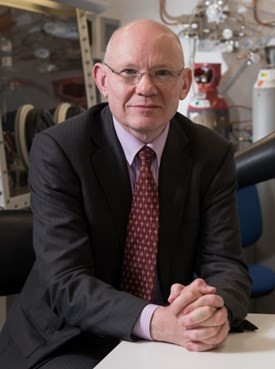“溥渊未来技术讲坛”:Solid-state batteries: opportunities and a challenge of interfaces
主讲人:Dr. Peter G. Bruce, FRS, FRSE, FRSC
时间:17:30-18:30, Feb.27, 2023
地点:Room 300, Longbin Building
讲座摘要
Solid-state batteries, in which the liquid electrolyte used in today's lithium-ion batteries is replaced by a solid, could offer a leap forward in the performance and safety of batteries. They are regarded by many at the likely next big thing in battery tech. However, there are challenges facing solid-state batteries that require fundamental understanding of the science underpinning their operation. For example, at the negative electrode a Li metal anode is required to achieve high energy densities. On discharging such a cell, voids form at the Li/solid electrolyte interface due to limited Li metal creep at practical stack pressures and under practical currents. These voids accumulate on cycling, leading to detachment of the Li anode and consequently high local currents during charge, triggering growth of dendrites (filaments of Li metal that penetrate the ceramic electrolyte). Li dendrites can penetrate ceramics even with densities of 99%. When they reach the cathode (positive electrode) the cell shortcircuits and fails catastrophically.
I shall discuss the challenges at the Li/solid electrolyte interface; voiding on discharge and dendrites on charge. Combined operando X-ray CT and modelling reveals insights into both processes. For example, dendrite initiation, then propagation across the solid electrolyte are revealed as separate processes, leading to differentconclusions as to how they might be mitigated. Even low (few MPa) stack pressures can be detrimental, leading to rapid propagation of dendrites and short circuit. Interlayers placed between the solid electrolyte and anode current collector can protect the solid electrolyte against dendrite growth while promoting more homogeneous deposition of Li metal in cells initially devoid of Li. This matters because cells initially constructed free from Li metal have higher energy densities and are easier to fabricate. Carbon-based interlayers will be discussed, revealing the structural changes within the interlayer and Li deposition behaviour during the processes of charge and discharge. The performance limits and failure mechanisms of the interlayer will be considered.
主讲人简介

Peter Bruce is Wolfson Professor of Materials at the University of Oxford, UK. He co-founded the Faraday Institution, the UK centre for research on electrochemical energy storage, and serves as its Chief Scientist. In 2018 he was appointed as Physical Secretary and Vice President of the Royal Society.
Peter's research interests embrace materials chemistry and electrochemistry, especially lithium and sodium batteries. Recent efforts have focused on the synthesis and understanding of new anionic redox cathode materials for lithium-ion batteries, the challenges of the lithium-air battery and understanding the processes taking place in solid-state batteries.
Peter's research has been recognised with a number of prestigious awards and fellowships. He has received the Tilden Prize, the Liversidge Award and the Longstaff Prize from the Royal Society of Chemistry, the Carl Wagner Award of the Electrochemical Society and the Hughes Medal of the Royal Society. He has been named as a Highly Cited Researcher by Thomson Reuters/Clarivate every year since 2015. In the 2022 Birthday Honours List, Peter received a knighthood for his services to science and innovation.







